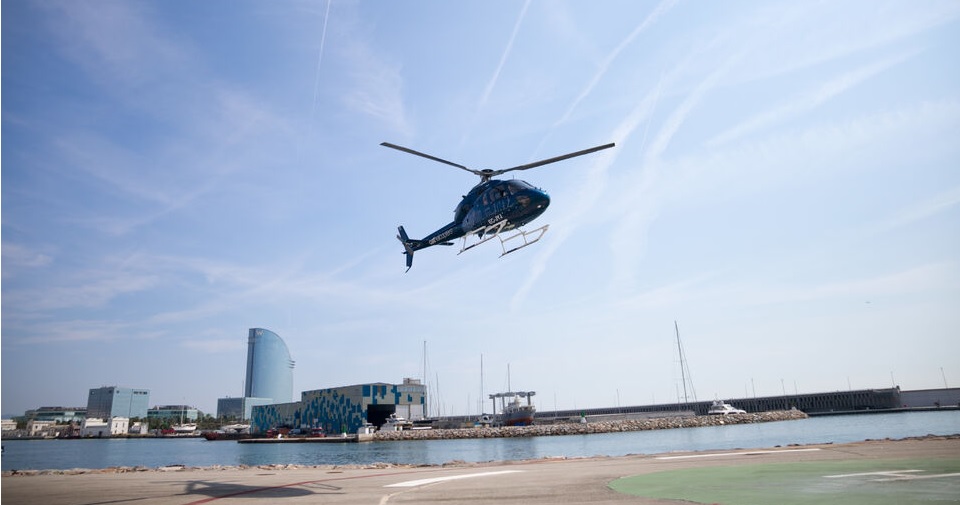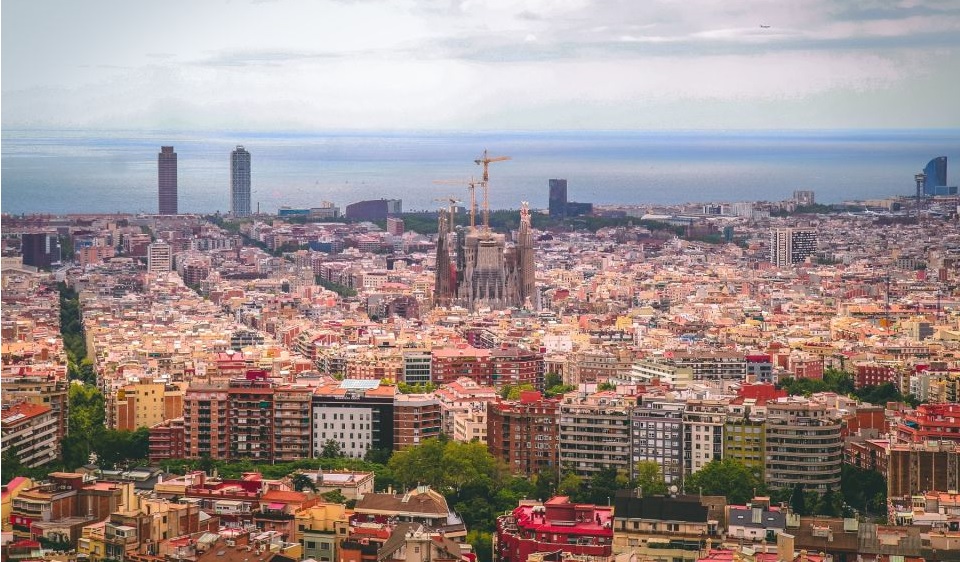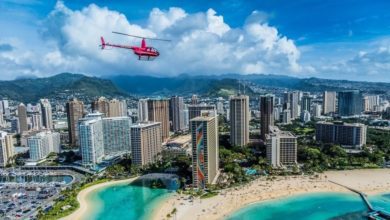
Barcelona is one of the most breathtaking cities in the world, thus making it one of the top tourist destinations no matter the season. However, regular walking tours can get a bit monotonous.
What you need is to shake things up and check out another way to see this incredible city. The best way to do that is by taking things to the air and sea with one of the top 4 helicopter tours in Barcelona!
We’ve had the rigorous task of trying out just about every tour they offer, and have compiled a list of the 4 best tours out there.
Best Helicopter Tours in Barcelona
| Helicopter, Walking, and Sailing 360 Degree City Tour | Helicopter Flight and Yacht Cruise Combo | Walking Tour, Sailing Trip & Helicopter Flight |
|
|---|---|---|---|
 |  |  |
|
| Departure Point: | Near Paseo de Garcia | Check-in at the Sailing Experience Barcelona office located in Port Olimpic | Placa de Catalunya |
| Departure Time: | N/A | 9:30 AM or 12:00 PM | N/A |
| Duration: | 4 hours | 1.5 hours (each sail and cruise) | 4 hours |
| Includes: | Bilingual tour guide, walking tour of the Gothic Quarter and Passeig de Gràcia, helicopter flight (6 minutes), waterfront boat trip (Goleta or Eco Boat) | 5-minute helicopter flight, 1.5-hour yacht cruise, light snacks of olives, cheese and fruit on board the boat, wine, beer, sangria, cava and vermouth on board the boat, heliport and local taxes, professional skipper | Local guide throughout the tour, radio system, 2-hour cruise on a 14-meter sailing boat, drink, snacks, professional skipper, helicopter tour of Barcelona, headphones |
See our other Barcelona tours: Sailing & Sunset Sailing Cruises, Barcelona Winery Tours, Barcelona Hot Air Balloon Rides.
Barcelona Helicopter Tour Reviews
1. Helicopter, Walking, and Sailing 360 Degree City Tour
- Duration: 4 hours
- Includes: Bilingual tour guide, walking tour of the Gothic Quarter and Passeig de Gràcia, helicopter flight (6 minutes), waterfront boat trip (Goleta or Eco Boat)
- Departure Point: Near Paseo de Garcia
- Other: Combines history, sea, and modern sites
Starting things off with a bang, we bring you the Helicopter, Walking, and Sailing 360 Degree City Tour. This 4-hour tour covers all the main areas of interest, by land, sea, and air! Barcelona is an incredibly vast, diverse city and this tour is one of the smartest ways to cover a lot of area in a short amount of time (not to mention in an unforgettable way!).
Before you begin, you’ll meet your guide near Passeig de Gracia. This half-day tour is just as versatile as the city itself, starting off with a stroll through the Old City or “Ciutat Vella”. This area consists of El Raval, Barri Gotic, El Born, and La Barceloneta – the famous neighborhood known for its incredible restaurants, tapas bars, and amazing beach.
You’ll even get to pass by some homes designed by the infamous Antoni Gaudi! Once you arrive to the Barri Gotic (Gothic Quarter), you’ll get to see the neighborhood which was once an old Roman village.
Nowadays, the neighborhood features a blend of peaceful plazas along with trendy bars, clubs, and street food vendors. Constructed between the 13th and 15th centuries, it’s cool to see how much the city has changed yet how much still remains.
You’ll get to walk around Placa de Sant Jaume, where many important, beautiful government buildings of sit. Amongst them, are the Town Hall and the Palace of the Generalitat of Catalonia. After your guide fills you in about their interesting history, you’ll move onto the old Jewish Quarter and see the incredible church of Santa Maria del Pi.
Las Ramblas is one of the most famous streets in the world. The tree-lined way allows for a pleasant stroll on the way to Port Vell. At the port is where you’re going to catch your boat and sail along the golden coastline. You’ll get plenty of fresh air and photo ops with the skyline contrasting against the rich blue sea.
You’ll get to catch a peek at the Christopher Columbus statue while getting into your transfer to take you to the heliport. Once inside your helicopter, you’ll fly up into the clear skies and enjoy the city that you just saw by foot.
Not only that, you’ll fly over the Olympic Port, Olympic Village, mouth of the Besos River, and much more. This is an experience that will absolutely blow you away.
More Information & Tour Booking
100% refund for cancellations within 24 hours of tour experience
2. Helicopter Flight and Yacht Cruise Combo
- Duration: 1.5 hours (each sail and cruise)
- Includes: 5-minute helicopter flight, 1.5-hour yacht cruise, light snacks of olives, cheese and fruit on board the boat, wine, beer, sangria, cava and vermouth on board the boat, heliport and local taxes, professional skipper
- Departure Point: Check-in at the Sailing Experience Barcelona office located in Port Olimpic. For the helicopter flight, meet at Cat Helicopter, Helipuerto de Barcelona, Moll Adossat S/N, 08039 Barcelona.
- Other: Luxurious and adventurous way to see all of the city
Everyone sees Barcelona from the ground, but it’s very rare to see it from the sea and air! With the Helicopter Flight and Yacht Cruise Combo you can see it all and have a unique experience to share with friends and family!
To start, you’ll meet at Moll de Mestral to depart on the luxury yacht with your group. The 12-meter yacht is the perfect size to fit a small group without being squished together. With a professional skipper helping you out, you can rest assured that you’ll be safe the entire journey.
While you sail around, you’ll take in much more than fresh air and sea breeze! You’ll get to see the infamous Christopher Columbus monument, which was constructed in 1888 in honor of his first voyage to the Americas. After all, Columbus reported to Queen Isabella I and King Ferdinand V in Barcelona right after his first journey to the area.
You can also see the one-of-a-kind Maremagnum shopping mall and entertainment complex which sits right on the water! However, you’ll be having even more fun on board sipping complimentary drinks, including all types of local wine, beer, and cocktails. Fresh fruit and light snacks are also included.
Once back on shore, you will then board the helicopter. Up high in the sky, you’ll get to see just about every part of the city. This birds-eye view is very special, so try to take at least a few photos or videos! Just remember that they’re not exactly consecutive, so you’ll have to choose which time you’d like to do your sailing and flying times:
Fly PM and sailing AM: sail starting at 9:30 AM or 12:00 PM / helicopter between 2:00 PM and 5:30 PM Fly AM and sailing PM: sail starting at 2:30 PM or 4:30 PM / helicopter between 10:30 AM and 2:00 PM.
More Information & Tour Booking
100% refund for cancellations within 24 hours of tour experience
3. Walking Tour, Sailing Trip & Helicopter Flight
![]()
- Duration: 4 hours
- Includes: Local guide throughout the tour, radio system, 2-hour cruise on a 14-meter sailing boat, drink, snacks, professional skipper, helicopter tour of Barcelona, headphones
- Departure Point: Placa de Catalunya
- Other: Comprehensive tour of Barcelona seen by land, sea, and air
You can’t get a more comprehensive tour of Barcelona than one that takes you by sea, air, and land! This 4-hour journey packs a ton into just one afternoon, so make sure you come prepared with lots of energy! Your tours will include the rest, such as beverages, snacks, and more. You may want to bring a light jacket for the sail, though!
You’ll meet with your guide and rest of your group at Plaça de Catalunya and begin your guided tour. This stroll will wind throughout the Old Town and Gothic Quarter.
As with any trip to Barcelona, it’s important to make a trip through Las Ramblas and La Boqueria Market. La Boqueria started almost 200 years ago as various meat stalls. Today, they offer all kinds of beverages and bites with over 300 stands!
Absorb interesting facts and history lessons from your guide as you visit Plaça del Rei, Barcelona Cathedral, and Plaça Sant Jaume. To finish up the walking section of your adventure, you’ll head over to Museu d’Historia de Catalunya and La Barceloneta neighborhoods. The latter is very trendy and full of delicious restaurants and fashionable bars.
Once you hit the port area of Barna, you’ll board your 14-meter sailboat. An expert skipper will be there to guide you and ensure you have the most fun possible while keeping safe. While you sail you’ll enjoy some snacks while you take in the view of the skyline, the sea itself, and the varied array of vessels on the water!
You’ll see everything from the most posh yachts to the most heavily-rigged fishing vessels out there!
Once you’ve had enough sea for the day, you’ll get back to shore where you’ll board your transfer to the helipad. Your guide will give you a quick recap of everything you need to know while onboard and what to expect. After boarding and taking off, you’ll have a prime spot of the city.
Experience all the city center and oldest neighborhoods from the air, including getting pretty close to the legendary La Sagrada Familia! If you’re limited on time in the city or just want a much rarer way of experiencing it, you can’t miss the Walking Tour, Sailing Trip, and Helicopter Flight Barcelona Tour.
More Information & Tour Booking
100% refund for cancellations within 24 hours of tour experience
4. Ferrari Driving and Helicopter Experience
- Duration: 30 minutes
- Includes: 20-minute guided Ferrari driving experience, 10-minute helicopter tour, Ferrari rental and fuel
- Departure Point: Drive Me Barcelona in Passeig de Joan de Borbó, 86, next to the Port Cable Car
- Other: Get to drive a Ferrari and a helicopter ride!
Do you have the need for speed? Do you wish you could live a little more on the edge like something out of a Fast and The Furious film? Well, that’s all possible on the Ferrari Driving and Helicopter Experience right here in Barcelona. It may be a quick trip, but it’ll certainly be one you want to repeat even years from now.
You’ll start by meeting your guide and getting into the driver’s seat of a bright-red Ferrari California. While there’s a ton of raw power in the machine’s 4.3-liter V8 engine, you’ll have to take it easy as you’ll be navigating the city’s streets.
This is a wonderful way to get to know the city and have more of a local’s perspective on how to get around. While you’ll still want to keep your eyes on the road, you’ll pass by many important landmarks and get to see the stunning stonework of centuries-old buildings and the Port of Barcelona.
Driving around the port is an unforgettable experience, and will really make you feel like you’re living the dream. Once you get to the port, you’ll drive up to the landing pad and jump into a helicopter. Okay, you won’t literally be jumping (that’s for another kind of tour).
Once you board, your pilot will take you high in the air – all the way over the rooftops! If you’ve never done this before, it may seem scary at first being in such a little aircraft. But trust us – after a few seconds you won’t want the tour to end!
Soar past the Sagrada Familia and catch up-close, rare vistas of this jaw-droppingly complex structure that’s still currently being built! La Plaza de España is another site to see, no matter from which angle.
The Renaissance/Moorish-type structure was created for the 1929 Ibero-American Expo and there’s nothing else like it. Covering over 50,000 square meters, it’s absolutely massive, too!
Soar along the coastline afterward and just take in the beauty Mother Nature has bestowed upon us! Finally, you’ll make a soft landing and decide where you want to take the night afterward. Keep in mind that this is a 2-traveler package so you will definitely want to take a another person with you.
When it comes to the Ferrari driving, you’ll have to decide who will drive and who will take the backseat as the instructor/guide will be riding shotgun.
More Information & Tour Booking
100% refund for cancellations within 24 hours of tour experience
Barcelona Spain Travel Guide

During its long and fascinating history, Spain has done more to shape the modern world than any other country. Though nobody today would condone the actions of the Conquistadors in America, Spain did form the first major global empire and forever change the world map.
From Santa Cruz de Nuca in British Columbia down to Santiago de Chile in the far south, Spain left its footprint across the whole of the Americas. Yet the nation itself is relatively small, with a population or only 47 million, not all even identifying as Spanish or speaking Spanish.
Spain is in fact a divided nation. The northeastern autonomous community of Catalonia contains 8 million people who identify as Catalan not Spanish. As recently as 2017, this region attempted to become fully independent from Spanish rule. This region contains Barcelona, Spain’s second largest city, as well as much of Spain’s industry.
When visiting Spain, most people head first for three cities. In the north, Barcelona is the cultural and historical capital and the most popular destination. In the south, Granada is a focal point, featuring the ancient Moorish palace of the Alhambra. And in the center, you will find the capital city — Madrid. There are other wonderful places to visit in this diverse and culturally rich nation, notably Seville and Salamanca, but those three cities are by far the most interesting.
Traveling in the time of COVID
Like many destinations, some tours and visitor attractions in Spain have adopted special precautionary measures during the pandemic.
Face masks are mandatory in some locations, notably in enclosed public areas such as travel hubs and shopping malls. You are expected to supply your own mask and wear it when you enter buildings.
It is in your own interest to keep your distance from other visitors who are not in your family group or bubble. You are expected to keep your distance inside boats, coaches, train compartments, and other vehicles and when seated in restaurants.
At the time of writing, Spain welcomes visitors and visas are not required for US citizens. However, with the exception of children aged 12 and under, every person arriving in Spain must provide a negative COVID-19 test certificate (NEAR, LAMP, TMA, or PCR — NOT an antigen test) or proof of being fully vaccinated at least 14 days before entry using a vaccine authorised by the WHO or the European Medicines Agency. This certificate must be time stamped within 72 hours.
You can obtain the most up-to-date information directly from the Spanish government’s Spain Travel Health portal. During these relatively uncertain times, it is wise to also consult the US Department of State website for current travel advisories.
Airports & Entry
You can enter Spain by sea, land, or air. What works best depends upon where you’re coming from. However, if you are traveling more than a hundred miles, it is best to fly. It is cheapest and most efficient to arrive by airplane.
Spain boasts 47 airports, and most of them handle international flights. This is because there are so many popular tourist destinations, including many of the Balearic Islands in the Mediterranean Sea that are popular clubbing spots for youths from across the whole of Europe.
When planning a journey to Spain, it is important to decide what cities you most want to see before flying and to compare ticket prices carefully. Because of the different airlines serving different airports, you will find an astonishingly broad range of prices.
It’s difficult to generalize due to competition between the airlines, but typically it’s much cheaper to fly into the two busiest airports in Spain: Madrid-Barajas and Barcelona El Prat. Direct flights to Granada, Seville, and Salamanca tend to be much more expensive.
Planning Tips
Spain is a fascinating country with a rich history and culture, which is why it is one of the most visited tourist destinations in Europe. Here are a few specific tips to help you get the most out of your vacation.
If you have tips of your own about this beautiful country, please share them with other readers in the comments below.
Tip #1: Travel there for less
It is both easiest and most cost effective to enter Spain through one of the two most popular international airports — Madrid and Barcelona. Because they are such popular destinations, don’t just book a ticket with your favorite airline. Instead, shop around. To get the best flight times and cheapest rates, aim to book 3 months in advance.
Time of year is a major factor in flight prices. During the long summer vacation and Easter, flights cost much more due to the high demand. Planning your vacation outside of these two high seasons will save you a lot of money in flights and hotel rooms.
#2. Enjoy free tours
Though you will want to enjoy some tours that aren’t free, such as a Mediterranean boat cruise, you will find free walking tours in some cities such as Barcelona. For example, Free Walking Tours Barcelona offers a free 2.5 hour walking tour of the historic city center along streets laid out by Roman planners 2,000 years ago and lined with breathtaking Medieval buildings. The expert guide will entertain you with information about the local history and culture as well as anecdotes about the many famous articles who have lived in Barcelona, such as Picasso and Gaudi.
#3. Eat for less
If you’re staying in Barcelona, ask about the menú del día at local restaurants. This is a set price, 3-course meal with a drink offered weekday lunchtimes and occasionally on weekends. You can enjoy a complete traditional meal for as little as €15. Typically, the menú del día is not advertised, so you must ask.
There is also a menú del noche during the evening. This costs more than the lunchtime meal but still works out much cheaper than selecting dishes from the expensive menus found in tourist traps.
#4. Pay less for museums
Across Spain, many museums offer free entry on the first Sunday of every month. In Barcelona, this is the evening of the first Sunday. Time your vacation to coincide with the first Sunday and head for the most expensive museum you want to visit on that day.
#5. Book Ahead
There are many tours you can enjoy around major tourist attractions in Spain that provide you with transport and an expert guide and work out costing less than taking public transport and paying an entrance fee. However, you must book in advance to avoid possible disappointment because these tours are understandably often fully booked weeks ahead of time.
Restaurants & Eating Out
Spanish cuisine is strongly influenced by its rich history. You can find traces of Roman, Arabic, and Mediterranean dishes as well as imports from its former colonies. Specific traditional dishes vary around the country depending upon geographical position.
Mediterranean
Spanish regions along the Mediterranean coast obviously feature seafood on their menus alongside signature local dishes. Typically, these dishes involve copious use of the olive oil so popular in Mediterranean countries. In Andalusia, the most southerly region, the local specialty is cold soups like gazpacho, with crushed cucumber, onion, pepper, tomato, and garlic. Calamares a la Romana is popular, but it is not for the squeamish. This is battered, deep-fried squid served with lemon and salt.
Rice-based dishes are popular along the coast, especially seafood paellas. The most famous paella is found in Valencia, though this features chicken and rabbit meat. In Catalonia, arros negre is popular.
Atlantic
Spicy fish or vegetable-based stews are popular along the Atlantic coast, such as fabada Asturiana, marmitako, and caldo Gallego. Chorizo is also popular. This spicy sausage is slightly sweet and utilizes lots of garlic. Sometimes it seems that each town and village boasts its own special chorizo recipe that is claimed to be better than all the others, such as the renowned chorizo Riojano. Fabada Asturiana is a white-bean stew from Asturias that makes ample use of the local chorizo variety.
Inland
Because historically food transportation was difficult and the central region imported much of its food from the coastal areas, the central regions are known for preserved foods, like Spanish ham and Manchego cheese. Inland, thick, spicy stews are also popular, like cocido madrileño. The most famous Spanish ham is jamon Iberico made from Black Iberian pigs and featuring a distinctive rich, savory taste.
Nightlife & Entertainment
Spain is famous world-wide for its fiestas, and its Balearic Islands are at the heart of the modern nightclubbing scene. For this reason, many travellers come to Spain specially to experience its vibrant nightlife. The island of Ibiza is renowned as Europe’s party capital, but the major cities each offer their own brand of exciting evening entertainments. Madrid’s nights are reputed to be never-ending.
A typical Spanish evening out begins with a visit to the small restaurants and bars for tapas to line the stomach. This transitions into bar hopping before hitting the huge international nightclubs found in all major cities. Due to relaxed licensing laws, these clubs and bars remain open until the early morning hours.
When staying in any Spanish city, it’s a good idea to gain some local insights from your hotel’s staff or tourist guides. The central streets and plazas are typically lined with bars that offer an eclectic mix of music and that are designed for people with different tastes. Rather than waste your time pushing through the crowds to then listen to music that isn’t your style, tell a local what you like and follow their directions. You can be certain that there is a live music venue that will cater to your tastes.
According to popular opinion, the three top nightlife spots in Spain are Ibiza, Madrid, and Barcelona. Ibiza, of course, caters to the young crowd with its mega clubs and all-night beach parties. Madrid is renowned for the huge variety of nightlife it offers where everyone is guaranteed to find a scene they enjoy. Barcelona’s nightlife is noted for its spectacular displays and wild abandon. But the nightlife isn’t limited to just these three locations since music and fiestas run in the Spanish blood. You can find a selection of lively bars and clubs in any Spanish town or city.
If you’re looking for an upscale experience, Marbella is the place to go. That’s where you’ll find the more exquisite cocktail bars and the difficult-to-enter clubs filled with the wealthy folks and celebrities. If it’s a pub craw you prefer, Malaga is famous for having the most bars per square foot in Europe. Granada is noted for its student vibe, Valenicia for its boho chic bars, and Bilbao for its funky nightspots. But if you want a truly exclusive Spanish experience, head for Seville. That’s where you can watch or maybe join in with traditional flamenco dancers.
Getting Around
It’s easy to get around Spain by airplane, train, coach, or hire a car. In fact, you’re spoiled because Spain’s transport network is so good.
Air
Unlike many other countries, domestic flights are relatively frequent and affordable throughout Spain. Trains are typically cheaper, but you can often find air tickets for less than the same train journey, so it’s always worth checking both options before booking. However, if you fly, you do have the extra hassle of transferring from the airport to the city center while the main train stations are typically in the heart of the cities. As a general rule, if you’re traveling from one side of the country to the other, take a plane. If you’re traveling between neighboring cities, take a train.
Train
Spain also boasts Europe’s most extensive high-speed railway network. Spanish trains regularly reach speeds of up to 190 mph! Check comparison websites before booking any train tickets because you can sometimes pay much less if you travel on a different train or sometimes by flying.
Coach & car
Because the trains are so efficient and there are also lots of domestic air flights, it’s not a great option to go by coach or to hire a vehicle. If you have lots of time and a tight budget, long-distance coaches can be much cheaper than the trains or planes.
Driving your own car gives you much more flexibility than you could ever get from a train. You will be able to visit and explore remote rural locations other tourists never see. However, you will find that your long-distance journeys take a lot longer by car or coach when compared with the high-speed train. Sadly, even if you hire a Ferrari, you won’t be allowed to drive along the Spanish roads at 190 mph.
Accommodations
Hotels vary across Spain depending upon where you’re staying. In Barcelona and Madrid, prepare to pay higher prices, especially during Easter and summer. Across the rest of the country, you can find rooms in a hostal for as little as €50 per night and in better hotels for around €100. Note that each city and region has its own high season due to special fiestas and local events, so it’s a good idea to research the specific towns you want to visit.
Booking in advance is highly advisable, especially during Easter and summer. Otherwise, you may not get the hotel you want or even the kind of room you prefer. You typically get the best deals in Spain by booking online. There are 5 general types of accommodation to choose from.
Paradores
The high-class hotels are called paradores. These boutique hotels are often converted castles or other historic buildings. For example, the Parador de Siguenza is a castle that dates back to Roman times, and the 15th-century Parador de Santiago de Compostela is said to be the world’s oldest hotel.
Hotels and hostels
In Spain, normal hotels are classed as either hotels or hostals. A hotel offers a full range of services but a hostal is a budget hotel with fewer services equivalent to a 1-star hotel. A standard hotel should be 3-stars, and a paradore is 5-stars.
Guesthouses
Bed and breakfasts are common around Spain. These are typically either fondas, which have a restaurant attached, or pensiones, which are budget guesthouses. If you’re an adventurer traveling by the seat of your pants, watch out for signs saying “B&B”, “Habitaciones”, or “Camas”.
Villas and apartments
Vacation properties are popular in Spain. If you’re traveling as part of a large family group, you’ll find a villa a cost-effective form of accommodation. However, they are typically rented by the week or longer, so not as flexible as a hotel or guesthouse.
Campsites
If you’re headed for the great outdoors, you’ll be delighted to learn that Spain is awash with affordable campsites that typically charge around €6 per person per night. However, research in advance because campgrounds near the most popular natural or cultural attractions charge significantly more.
Weather
Interestingly, Spain’s climate can be divided along the same lines as its cuisine. The three main zones are the Atlantic, the interior, and the Mediterranean.
Along the Atlantic coastline, the ocean ensures that the summers remain relatively cool and the winters mild. In the deep interior, the climate is semi-arid. Along the Mediterranean coast, the summers are dry and hot while the winters are mild.
If you’re interested in hiking and sightseeing, the temperatures are mildest in spring and in the fall. July and August see the highest temperatures which are great for sunbathing but a little too hot for admiring architecture or hiking through the wilderness. You can expect temperatures over 860F during the day and remaining over 700F at night. The coolest months are January and February, which see a lot of rain in the north.
A common mistake is to visit mountainous regions in the winter without taking proper winter clothing. While these high regions are baking hot in summer, those picturesque mountain villages are often dusted in snow during January and February.
Attractions
Spain is rich in history and culture, so there are lots of things to do and see around the country. Unless you’re most interested in the nightlife, the three top spots to visit are Barcelona, Madrid, and Granada.
Barcelona
Barcelona is a city rich in culture and art. A great place to start is La Rambla — a pedestrianized street where you’ll find human statures, street performers, Bouqueria Market, museums, and other attractions including the 197-foot high Columbus Monument. Don’t miss the Magic Fountain of Montjuic which features half-hourly music and light shows during the summer months and weekends. When the fountain is in action, its water sprays are lit in different colors and dance to the music.
If you are interested in modern art, you’ll be in Heaven. The Picasso Museum is renowned for its unique collection of Picasso memorabilia from his school workbooks right through to his final masterpieces. But the most obvious evidence of Barcelona’s fixation with modern art is Park Guell, which is filled with Gaudi’s unique sculptures and buildings.
But Gaudi’s greatest accomplishment is unarguably the Sagrada Familia. This strangely designed basilica has become Barcelona’s most famous landmark, and it isn’t even finished yet. Gaudi laid out the plans and began the work, but the basilica will not be completed until around 2026.
If soccer is more your style, you’ll want to visit the world-famous Barcelona FC Museum. There you can learn all about the training and lifestyle of the world’s highest paid soccer players. A tour of the museum includes a visit to the players’ changing rooms and a walk through the tunnel onto the pitch itself.
History lovers should ride the Montjuic Cable Car to get scenic views of the city as they rise up to Montjuic Castle. This 17th-century fortress offers fantastic panoramic views of the city and a fascinating armour museum.
And your kids will love Tibidabo Amusement Park. This is one of the world’s oldest parks — much older than Disney World or Universal Studios. Some of the rides there are genuine antiques, and the suspended airplane ride is considered an iconic symbol of the city. Don’t miss the historic automation collection in the park.
Madrid
Madrid boasts a fine collection of historic buildings and the kind of internationally renowned museums you’d expect to find in any major capital city. The most iconic structure is the Palacio Real.
The Palacio Real, or Royal Palace, is the official palace of the King of Spain. Boasting 3,000 rooms and an amazing art collection, this is a fantastic place to learn about the glamor and luxury of a European royal family. During a visit, you’ll see a sweeping main staircase, the Throne Room, the Royal Chapel, and the Royal Apothecary.
Granada
Granada is reputed to be the most beautiful city in the world. However, most visitors head straight for the Alhambra. This Moorish fortress and palace is one of the world’s best examples of early Islamic architecture. Its breathtaking vistas, marble fountains, and unique mosaics are beyond compare. The palace began life as a Roman fort before the Moors invaded and made it their own. The Moorish fort was built in 889 and transformed into a much larger palace complex in 1333.
Visitors from the US will be particularly interested in visiting the throne room. This is where Christopher Columbus came to propose his voyage to the west to find a new trade route to India. If Queen Isabella had said no to his ambitious plans, the US and all the other American nations might not exist today.
Salamanca
If you want to explore beyond these three major tourist cities, head west to Salamanca to experience one of the world’s oldest universities. Salamanca is a UNESCO World Heritage Site because it is the third oldest university in the world founded in 1218. Arguably, it is really the world’s oldest university because it was the first officially granted university status by the Vatican, which was then the major power broker in Europe.
If you’ve ever seen Harvard or Oxford, you’ll know what kind of buildings to expect. However, here they have a more flamboyant Catholic touch, with more ornate details and bright colors. The main university library is a must-see attraction.
Summary – Whichever tour (or tours!) you choose, you’re almost guaranteed to have an incredible time. Barcelona is a one-of-a-kind destination, and is filled with sights you don’t want to miss. If you’re going to be there for less than a couple of weeks, walking tours just aren’t feasible if you want to catch it all. Offering both day and night tours, there’s absolutely something here that’s perfect for you!
Sites Seen
Tour Guides
Value
The Barcelona Helicopter, Walking, and Sailing 360º City Tour is our Editor's Choice tour.





